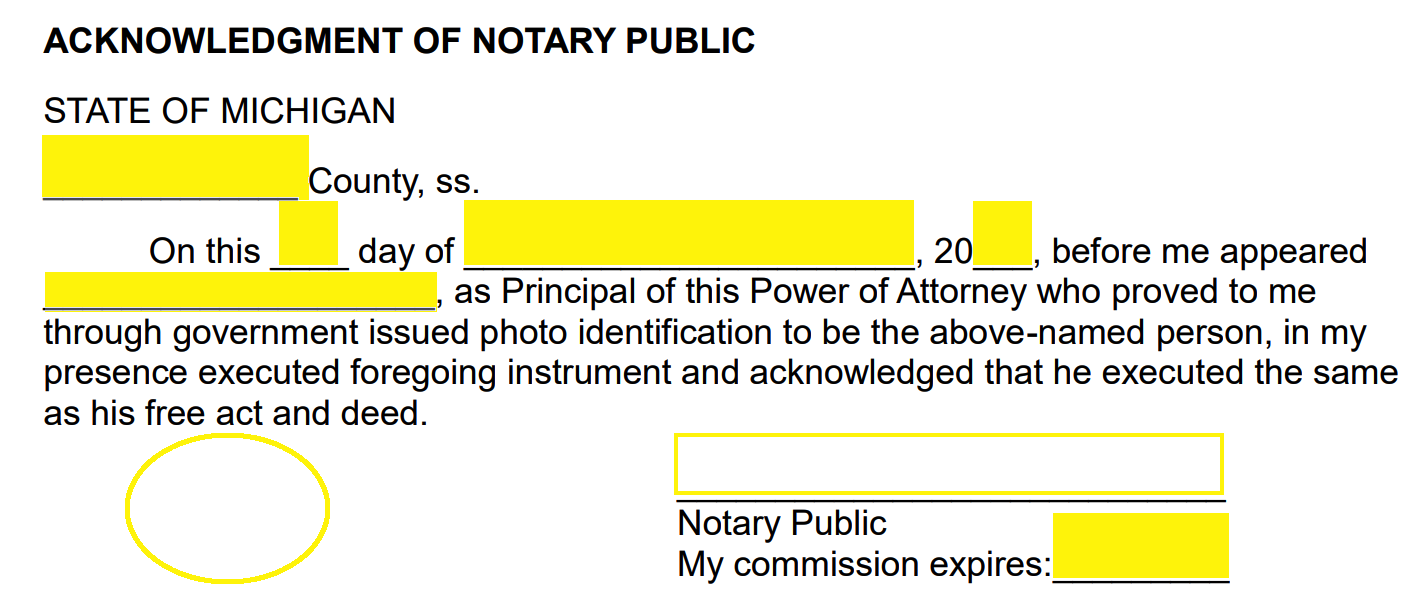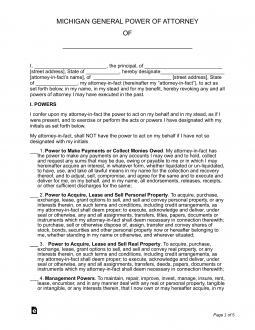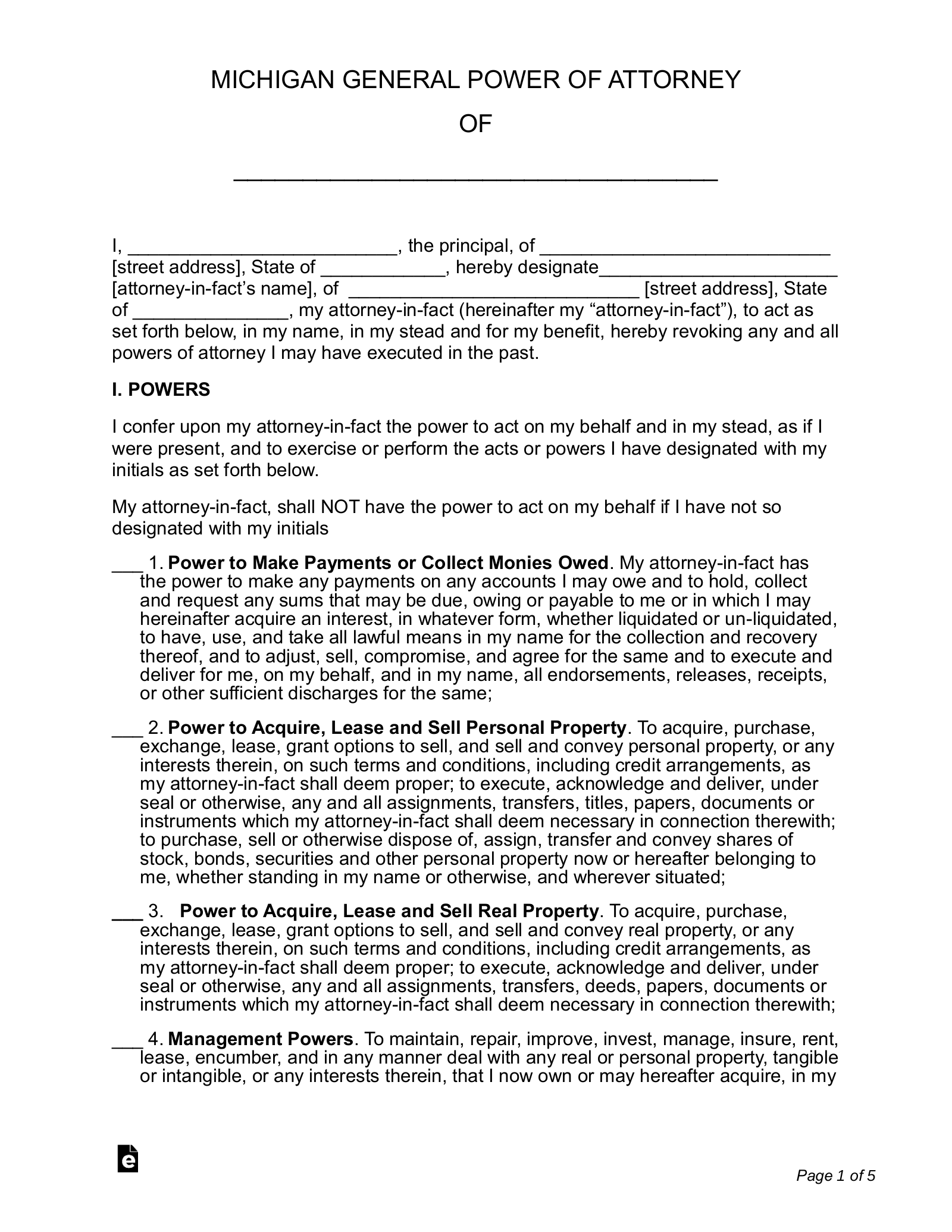Updated April 10, 2024
A Michigan general (financial) power of attorney form is a document that grants authority to another individual to act on your behalf for a period of time. It will be up to you to use this document to declare what actions this agent may take in your name, what decisions he or she can make, and when he or she may do so. Thus, if, for example, you are going to be unavailable with a long-term hospitalization or military deployment, then you can use this document to fully deliver the authority you wish bestowed upon your agent in the manner you wish. The important thing to note about the general POA is that it will become void if you are determined to be incapacitated. If you want one that continues in effect even after you become incapacitated, you should consider the Michigan durable POA.
Laws
- Statutes – Durable Power of Attorney and Designation of Patient Advocate
- Signing Requirements (M.C.L.A. 700-5501): The principal is required to sign the document in the presence of either a notary public or two (2) witnesses.
How to Write
Download: PDF, MS Word, OpenDocument
1 – The Principal And The Attorney-in-Fact Who Will Possess Principal Power
The blank line in the Title of this form will require the Name of the Principal filled in. This is the person who seeks to use this form as a method to appoint an Agent or Attorney-in-Fact with Principal Power.  The Name of the Principal should also be reported on the first blank line in the introductory paragraph. Then, record the Principal’s Residential Street Address on the second blank space (include the County or City). The third blank space must have the State where the Principal lives presented.
The Name of the Principal should also be reported on the first blank line in the introductory paragraph. Then, record the Principal’s Residential Street Address on the second blank space (include the County or City). The third blank space must have the State where the Principal lives presented.
The next set of blank spaces will require some similar information but in relation to the Attorney-in-Fact who will gain Principal Power through this form’s definitions. Locate the blank space just before the bracketed label “[Attorney-in-Fact’s Name],” then enter the Agent’s First, Middle, and Last Name. This Agent report should continue with the Agent’s Residential Street Address recorded on the next blank space and the State where the Agent lives entered on the last blank space in this statement.
2 – Article I Provides A List Of Powers For Principal Review
The next section, appropriately named “Powers,” will separate the various Subject Matters where a Principal will, generally, empower an Agent to utilize Principal Authority in. This list will only deliver the Powers it defines if the Principal initials the blank lines preceding these definitions. Any paragraph that has not been initialed by the Principal will be excluded from the Principal Authority being designated to the Attorney-in-Fact in this form.
Item Number 1, labeled “Power To Make Payments Or Collect Monies Owed,” will only be granted to the Agent if the Principal initials the blank space preceding the definition. 
If the Principal wishes to include the “Power To Acquire, Lease and Sell Personal Property,” in this form’s delegation of Power to the Attorney-in-Fact, then he or she should initial the empty line preceding the Number 2. Item 3 supplies the language required to empower the Attorney-in-Fact with the Principal “Power To Acquire, Lease and Sell Real Property” when it is initialed by the Principal.
Item 3 supplies the language required to empower the Attorney-in-Fact with the Principal “Power To Acquire, Lease and Sell Real Property” when it is initialed by the Principal.  The Attorney-in-Fact will have the ability to wield the same “Management Powers” as that of the Principal (as defined in the “Management Powers” paragraph) only if the Principal initials the empty line before preceding the Number 4.
The Attorney-in-Fact will have the ability to wield the same “Management Powers” as that of the Principal (as defined in the “Management Powers” paragraph) only if the Principal initials the empty line before preceding the Number 4. If the Principal wishes to give “Banking Powers” as those defined in the fifth paragraph, he or she will need to initial the blank space just before the Number 5.
If the Principal wishes to give “Banking Powers” as those defined in the fifth paragraph, he or she will need to initial the blank space just before the Number 5.  The Principal will deliver Principal Powers, to the Agent, over his or her “Motor Vehicles” by initialing the sixth statement.
The Principal will deliver Principal Powers, to the Agent, over his or her “Motor Vehicles” by initialing the sixth statement.  If the Principal wishes to grant the Attorney-in-Fact with the “Tax Powers” in Statement Number 7, then he or she will need to initial the corresponding blank space.
If the Principal wishes to grant the Attorney-in-Fact with the “Tax Powers” in Statement Number 7, then he or she will need to initial the corresponding blank space.
Access to the Principal’s “Safe-Deposit Boxes” will be granted to the Agent once the Principal initials the eighth paragraph.
The ninth paragraph on this list will empower the acting Primary Agent with the same “Gift Making Powers” as that of the Principal within the confines of the law and the definition provided. If the Principal has determined the Agent should wield this Authority, then he or she should initial the blank space provided.  The Principal’s Authority in “Lending And Borrowing” matters will be granted to the Agent if the tenth statement is initialed.
The Principal’s Authority in “Lending And Borrowing” matters will be granted to the Agent if the tenth statement is initialed.  The Agent will have the same Authority the possessed by the Principal when it comes to “Contracts” if the Principal Initials Item Number 11.
The Agent will have the same Authority the possessed by the Principal when it comes to “Contracts” if the Principal Initials Item Number 11. ![]() Paragraph Twelve will grant the Agent with Principal Powers in “Health Care” if the Principal initials this item.
Paragraph Twelve will grant the Agent with Principal Powers in “Health Care” if the Principal initials this item.  The Principal will grant the Attorney-in-Fact with the Representative Powers dictated in the Health Insurance Portability And Accountability Act of 1996 (Pub L. No 104-191) if he or she initials the blank space preceding the thirteenth paragraph.
The Principal will grant the Attorney-in-Fact with the Representative Powers dictated in the Health Insurance Portability And Accountability Act of 1996 (Pub L. No 104-191) if he or she initials the blank space preceding the thirteenth paragraph. ![]() The fourteenth subject matter will give the Agent the “Power To Hire And Pay For Services” on behalf of the Principal using Principal Authority, once the Principal initials this paragraph.
The fourteenth subject matter will give the Agent the “Power To Hire And Pay For Services” on behalf of the Principal using Principal Authority, once the Principal initials this paragraph.  If the Principal initials the fifteenth paragraph, the Agent will have the Principal Authority to seek reimbursement for any incurred expenses.
If the Principal initials the fifteenth paragraph, the Agent will have the Principal Authority to seek reimbursement for any incurred expenses. ![]() The “Power To Sue Third Parties Who Fail To Act Pursuant To Power Of Attorney” will be granted to the Agent upon the Principal’s initialing of Paragraph 16.
The “Power To Sue Third Parties Who Fail To Act Pursuant To Power Of Attorney” will be granted to the Agent upon the Principal’s initialing of Paragraph 16.
The Principal may have provided specifics regarding limitations or additions to the Principal Powers defined here that will be granted. Such provisions will need to be present (in writing) by the time the Principal signs this document. If any such instructions exist, they must be documented on the blank lines in the last item and the Principal must initial the blank space preceding the Number 17.
3 – When The Agent May Wield Power
The next section requiring attention will be the third Article, “Effective Date And Termination.” Here this section will have two defined areas to describe when the Attorney-in-Fact will be able to utilize these Powers and when the Attorney-in-Fact will no longer have access to the defined Principal Powers. This will be conveyed with the Principal initialing the appropriate statements.
First, the Principal must determine whether the Powers in this document are effective once he or she signs this form or if they are effective on a specific Date. If the Agent should have Principal Powers upon the Principal Signing, the Principal should initial the first statement. If the Principal has determined the Agent should have Principal Powers upon a specific future Date, he or she must initial the second statement then, enter the Date of Effect utilizing the spaces provided. 
Now that we have defined when the Principal Powers in this document will be available to the Agent, we will need to define when they will terminate. If the Principal wishes the Termination of Power to occur on a specific Date, he or she should initial the first statement in the second area and enter the Termination Date in the available spaces. If the Principal wishes the Agent to have Principal Power until he or she issues a Revocation, the Principal will need to initial the second statement. If the Principal wishes these Powers to be terminated only upon a written revocation or upon a Physician pronouncing the Principal unable to handle his or her affairs, then he or she must initial the third statement.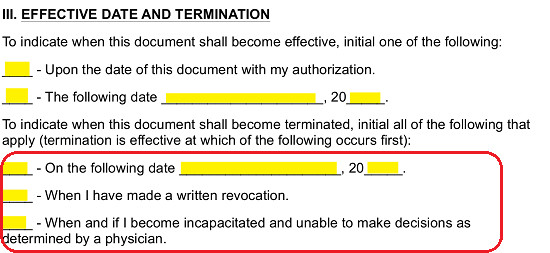
4 – The Closing Items Required By This Form
The final area the Principal must tend to is the closing statement. Locate the capital letters “IN WITNESS WHEREOF…” Here, the Principal must enter the Calendar Day, Month, and Year when he or she signs this document.  Below the bold letters “Principal’s Signature,” the Principal must sign his or her Name. The next empty line will require the Printed Name of the Principal.
Below the bold letters “Principal’s Signature,” the Principal must sign his or her Name. The next empty line will require the Printed Name of the Principal.  The next empty line will require the Printed Name of the Principal.
The next empty line will require the Printed Name of the Principal.
This form will contain two more signature areas. In the “Acceptance of Appointment” statement, present the printed Name of the Principal on the first blank line.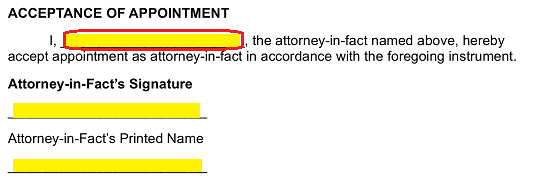 The second blank line in this section requires the Attorney-in-Fact’s Signature.
The second blank line in this section requires the Attorney-in-Fact’s Signature.  The third blank line in this section must have the Printed Name of the Attorney-in-Fact presented.
The third blank line in this section must have the Printed Name of the Attorney-in-Fact presented.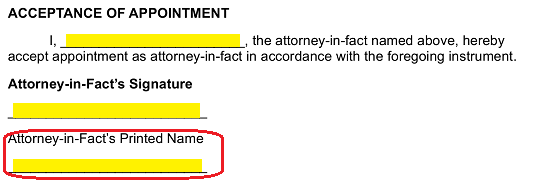
The “Witness” statement will have two defined Signature areas. This will provide two Witnesses to sign their Names and report their Residential Addresses.
The final section, “Acknowledgment Of Notary Public,” will also require attention but only from a Notary Public. The Notary Public will need to supply the information this section requires then provide the notarization seal.
